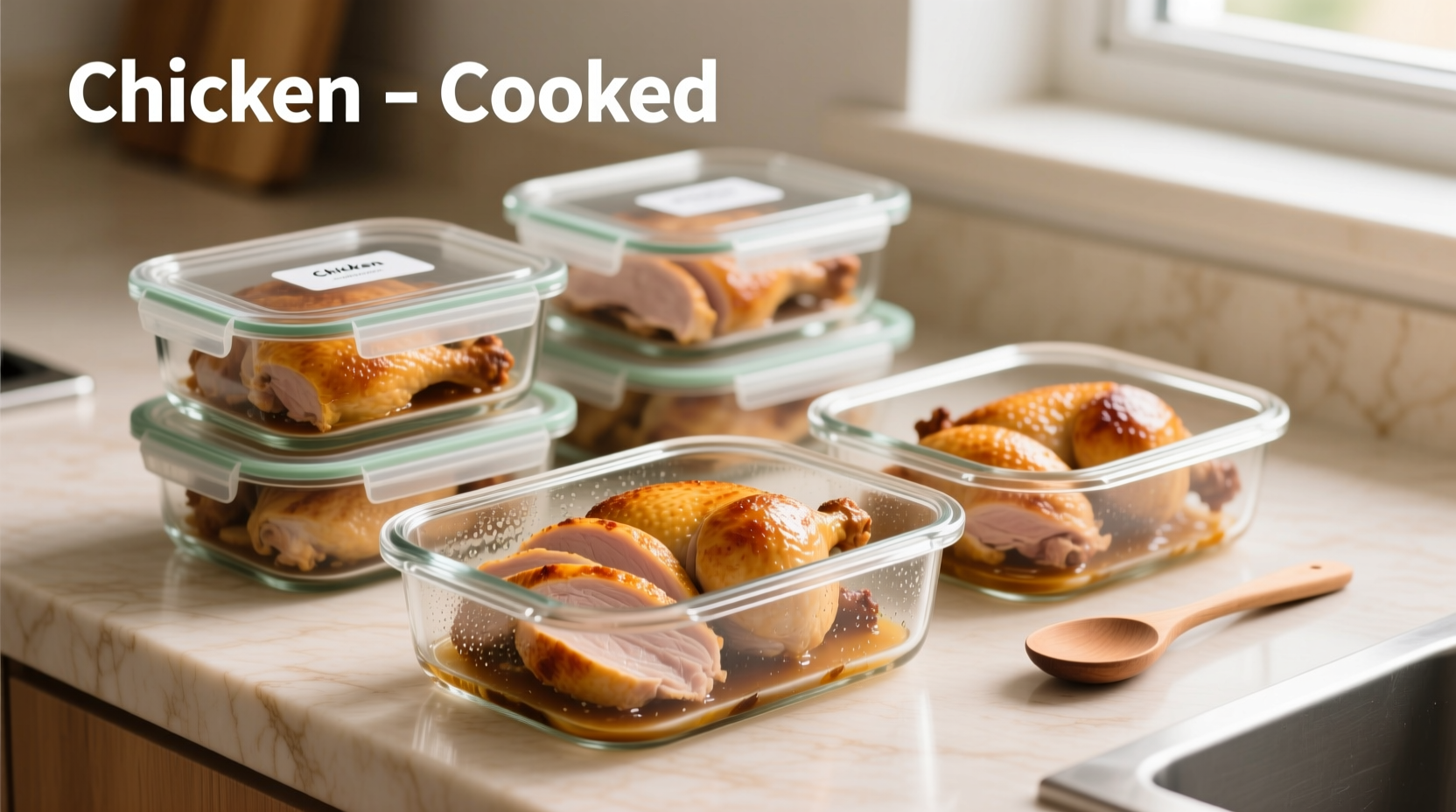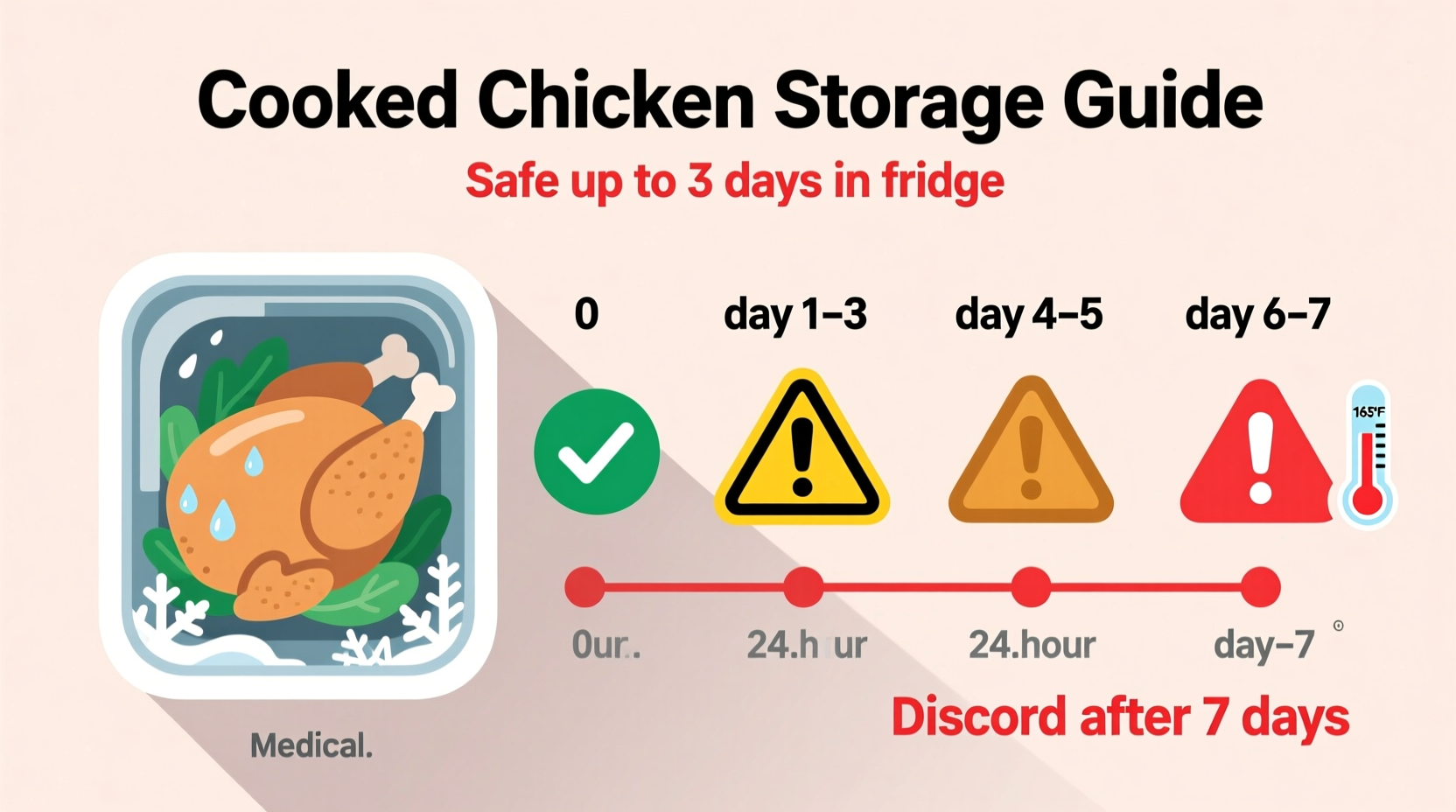Cooked chicken remains safe to eat for 3-4 days when properly refrigerated at 40°F (4°C) or below. In the freezer, it maintains best quality for 2-6 months. These timeframes vary based on storage conditions, cooking method, and whether the chicken was part of a mixed dish.
Ever wonder how long that roasted chicken or grilled chicken breast will stay safe in your fridge? You're not alone. Each year, millions of Americans face potential foodborne illness from improperly stored leftovers. As someone who's worked in professional kitchens from Michelin-starred restaurants to local food trucks, I've seen how small storage mistakes can compromise both safety and flavor. Let's cut through the confusion with science-backed guidelines you can trust.
The Science Behind Cooked Chicken Safety
Understanding why time limits matter requires knowing how bacteria behave. Cooked chicken enters what food safety experts call the "temperature danger zone" (40°F-140°F) as it cools. Within this range, bacteria like Salmonella and Staphylococcus aureus multiply rapidly. The USDA Food Safety and Inspection Service confirms that bacterial growth can double every 20 minutes in this danger zone.
Unlike raw chicken, cooked chicken has had its initial bacteria load reduced, but it's not sterile. Once cooked, it becomes susceptible to new contamination from hands, utensils, or improper storage containers. This is why the clock starts ticking the moment chicken finishes cooking.
Storage Timeline: What Actually Matters
Your refrigerator's actual temperature significantly impacts safety. A 2023 study by the FDA Food Code revealed that 43% of home refrigerators operate above the recommended 40°F threshold, dramatically reducing safe storage time. Here's how different storage methods affect your cooked chicken's shelf life:
| Storage Method | Safe Duration | Quality Indicator | Critical Factor |
|---|---|---|---|
| Refrigerator (40°F or below) | 3-4 days | Firm texture, normal appearance | Air-tight container within 2 hours of cooking |
| Freezer (0°F or below) | 4 months (plain), 6 months (in broth) | No freezer burn, consistent color | Vacuum-sealed packaging prevents oxidation |
| Room Temperature | 2 hours max (1 hour if above 90°F) | None - discard immediately | Time in danger zone accumulates |
| In Soup or Casserole | 3-4 days | Clear broth, no separation | Acidic ingredients may extend by 1 day |
Real-World Storage Scenarios You Need to Know
That container of leftover chicken salad follows different rules than plain roasted chicken. According to the USDA Food Safety and Inspection Service, mixed dishes containing mayonnaise or dairy typically have shorter shelf lives than plain cooked chicken. Chicken salad remains safe for just 3-5 days, while chicken in tomato-based sauces might last the full 4 days due to the acid's preservative effect.
Takeout chicken presents unique challenges. Many restaurants use containers that aren't fully airtight. Transfer takeout to proper storage containers within 30 minutes of arrival. The FDA Food Code notes that improper container transfer accounts for 27% of home foodborne illness cases from leftovers.
How to Spot Spoiled Cooked Chicken
Don't rely solely on timeframes. Your senses provide critical safety information. Spoiled cooked chicken typically shows:
- Visual changes: Grayish-green discoloration, especially around bone edges
- Smell test: Sour or ammonia-like odor (not just "different")
- Texture: Slimy film that persists after rinsing
- Mold: Any visible growth means immediate disposal
Remember: If chicken has been in the danger zone (40°F-140°F) for more than 2 cumulative hours, it's unsafe regardless of appearance. The "when in doubt, throw it out" rule isn't just cautious—it's scientifically sound advice from food safety experts.
Maximizing Safety and Flavor: Proven Techniques
Professional kitchens follow these evidence-based practices to extend cooked chicken's shelf life without compromising safety:
- Immediate cooling: Divide large portions into shallow containers (no deeper than 2 inches) to cool faster. The USDA recommends getting food below 70°F within 2 hours.
- Proper packaging: Use airtight containers with minimal headspace. Glass containers with locking lids outperform plastic in maintaining consistent temperature.
- Label everything: Note both date and time of storage. "Monday" isn't specific enough when dealing with 4-day limits.
- Strategic freezing: Portion chicken with broth or sauce to prevent freezer burn. Vacuum sealing extends freezer life by 50% according to University of Minnesota extension research.

Reheating Leftover Chicken Safely
Proper reheating is your final safety checkpoint. The USDA requires reheating cooked chicken to 165°F internal temperature, verified with a food thermometer. This kills any bacteria that may have developed during storage.
For best results:
- Add moisture when reheating to prevent drying
- Reheat only the portion you'll consume immediately
- Never reheat chicken more than once
- Stir soups and casseroles thoroughly for even heating
When reheating in a microwave, cover with a damp paper towel and rotate frequently. For oven reheating, use low temperatures (300°F) with added liquid to maintain moisture while ensuring thorough heating.
Special Cases You Should Know About
Certain situations require modified guidelines. Chicken cooked on a grill often has shorter shelf life due to potential cross-contamination from raw meat juices. Rotisserie chicken from grocery stores typically contains preservatives that extend shelf life slightly, but still follows the 3-4 day rule.
The CDC reports that stuffed chicken presents particular risks, as the stuffing creates additional moisture pockets where bacteria can thrive. Always remove stuffing before refrigerating and consume within 2 days.
When traveling or camping, use insulated containers with ice packs to maintain safe temperatures. The FDA Food Code specifies that perishable foods should not remain in insulated containers for more than 4 hours without temperature verification.
Your Action Plan for Safe Leftovers
Follow this simple decision tree next time you have cooked chicken leftovers:
- Within 2 hours of cooking: Divide into portions and store properly
- Daily check: Inspect for spoilage signs before consumption
- Day 3: Prioritize eating refrigerated chicken
- Day 4: Discard any remaining refrigerated chicken
- Freezer check: Every 3 months, verify frozen chicken shows no freezer burn
Remember that these guidelines apply to properly cooked chicken (reached 165°F internal temperature initially). Undercooked chicken has different safety considerations and should be consumed immediately or properly recooked before storage.
Common Questions About Cooked Chicken Storage
Can I eat cooked chicken after 5 days in the refrigerator?
No, cooked chicken should not be consumed after 4 days in the refrigerator. The USDA Food Safety and Inspection Service states that 4 days is the maximum safe storage time at 40°F or below. After this point, even if it appears normal, harmful bacteria may have reached dangerous levels.
Does freezing chicken indefinitely make it unsafe?
Frozen chicken remains safe indefinitely at 0°F or below, but quality deteriorates over time. The USDA recommends consuming frozen cooked chicken within 4-6 months for best quality. Beyond this timeframe, it remains safe but may develop freezer burn and lose flavor and texture.
How can I tell if cooked chicken has gone bad if I can't smell anything?
If cooked chicken feels slimy or sticky to the touch, shows discoloration (gray or green tints), or has visible mold, it has spoiled even if odorless. The USDA Food Safety and Inspection Service notes that some dangerous bacteria don't produce noticeable odors. When in doubt, use a food thermometer to check if it reached 165°F during reheating, but discard if any spoilage signs appear.
Is it safe to eat cooked chicken left out overnight?
No, cooked chicken left at room temperature for more than 2 hours (1 hour if above 90°F) should be discarded. The FDA Food Code states that bacterial growth accelerates in the temperature danger zone (40°F-140°F), and after 2 hours, harmful bacteria may reach levels that cause foodborne illness even after reheating.
Can I extend cooked chicken's shelf life by reheating it on day 3?
No, reheating cooked chicken on day 3 does not reset the safety clock. The USDA Food Safety and Inspection Service explains that each reheating cycle degrades quality and doesn't eliminate all potential toxins produced by bacteria during storage. Cooked chicken should be consumed within 3-4 days of initial cooking, regardless of reheating.











 浙公网安备
33010002000092号
浙公网安备
33010002000092号 浙B2-20120091-4
浙B2-20120091-4